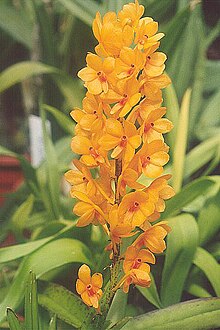| Revision as of 08:28, 9 February 2015 editYobot (talk | contribs)Bots4,733,870 editsm WP:CHECKWIKI error fixes using AWB (10820)← Previous edit | Revision as of 22:02, 9 February 2015 edit undoBgwhite (talk | contribs)Extended confirmed users547,151 editsm Do general fixes and cleanup. - using AWB (10822)Next edit → | ||
| Line 111: | Line 111: | ||
| *'']'': Wknsra (Ascocentrum x ] x ]) | *'']'': Wknsra (Ascocentrum x ] x ]) | ||
| *'']'': Ysfra (] x Ascocentrum x ] x ]) | *'']'': Ysfra (] x Ascocentrum x ] x ]) | ||
| <gallery> | |||
| <!-- Deleted image removed: Image:Ascocentrum ampullaceum.JPG|''Ascocentrum ampullaceum'' --> | |||
| </gallery> | |||
| == References == | == References == | ||
Revision as of 22:02, 9 February 2015
| Ascocentrum | |
|---|---|

| |
| Rust-red Ascocentrum (Ascocentrum miniatum) | |
| Scientific classification | |
| Kingdom: | Plantae |
| (unranked): | Angiosperms |
| (unranked): | Monocots |
| Order: | Asparagales |
| Family: | Orchidaceae |
| Subfamily: | Epidendroideae |
| Tribe: | Vandeae |
| Subtribe: | Aeridinae |
| Alliance: | Vanda |
| Genus: | Ascocentrum Schltr. ex J. J. Sm. (1917) |
| Type species | |
| Ascocentrum miniatum (Lindl.) Schltr. | |
| Species | |
| Synonyms | |
|
Ascolabium S. S. Ying | |
Ascocentrum, abbreviated as Asctm in horticultural trade, is a small genus belonging to the orchid family (Orchidaceae). The type species is Ascocentrum miniatum (Lindl.) Schltr. ex J. J. Sm. (originally as Saccolabium miniatum Lindl.).
They occur mainly in warmer to intermediate, humid climates of the foothills of the Himalayas, in Myanmar, Thailand, Malaysia, the Philippines, Java and Borneo.
These monopodial epiphytic orchids grow on deciduous trees. They have a short, simple to bifurcate stem (max. 15–18 cm) with an upright, compact, conical to racemose inflorescence, consisting of smaller brightly colored flowers. These flowers have a prominent spur and a strap-like lip. Their bright colors vary between yellow, orange, red, orchid or cerise.
The chromosome number is 2n = 38.
They are popular among orchid lovers because they resemble the compact Vanda-like species. Nevertheless their cultivation is rather difficult.
Intergeneric hybrids
They are generally crossed with Vanda species into numerous intergeneric hybrids, giving the following nothogeneric names (i.e. the name at generic rank for a hybrid between representatives of two or more genera)
- Aeridocentrum: Aerctm (Aerides x Ascocentrum)
- Aerasconetia: Aescta (Aerides x Ascocentrum x Neofinetia)
- Alphonsoara: Alph (Arachnis x Ascocentrum x Vanda x Vandopsis)
- Angraecentrum: Angctm (Angraecum x Ascocentrum)
- Ascandopsis: Ascdps (Ascocentrum x Vandopsis)
- Ascocenda: Ascda (Ascocentrum x Vanda)
- Ascocleinetia: Ascln (Ascocentrum x Cleisocentron x Neofinetia)
- Ascofinetia: Ascf (Ascocentrum x Neofinetia)
- Ascogastisia: Agsta (Ascocentrum x Gastrochilus x Luisia)
- Ascoglottis: Asgts (Ascocentrum x Trichoglottis)
- Asconopsis: Ascps (Ascocentrum x Phalaenopsis)
- Ascorachnis: Ascns (Arachnis x Ascocentrum)
- Ascovandoritis: Asvts (Ascocentrum x Doritis x Vanda)
- Beardara: Bdra (Ascocentrum x Doritis x Phalaenopsis)
- Bokchoonara: Bkch (Arachnis x Ascocentrum x Phalaenopsis x Vanda)
- Bovornara: Bov (Arachnis x Ascocentrum x Rhynchostylis x Vanda)
- Chilocentrum: Chctm (Ascocentrum x Chiloschista)
- Christieara: Chtra (Aerides x Ascocentrum x Vanda)
- Darwinara: Dar (Ascocentrum x Neofinetia x Rhynchostylis x Vanda)
- Debruyneara: Dbra (Ascocentrum x Luisia x Vanda)
- Devereuxara: Dvra (Ascocentrum x Phalaenopsis x Vanda)
- Dominyara: Dmya (Ascocentrum x Luisia x Neofinetia x Rhynchostylis)
- Doricentrum: Dctm (Ascocentrum x Doritis)
- Eastonara: Eas (Ascocentrum x Gastrochilus x Vanda)
- Fujioara: Fjo (Ascocentrum x Trichoglottis x Vanda)
- Gottererara: Gott (Ascocentrum x Renanthera x Vandopsis)
- Himoriara: Hmra (Ascocentrum x Phalaenopsis x Rhynchostylis x Vanda)
- Hugofreedara: Hgfda (Ascocentrum x Doritis x Kingiella)
- Isaoara: Isr (Aerides x Ascocentrum x Phalaenopsis x Vanda)
- Kagawara: Kgw (Ascocentrum x Renanthera x Vanda)
- Knappara: Knp (Ascocentrum x Rhynchostylis x Vanda x Vandopsis)
- Knudsonara: Knud (Ascocentrum x Neofinetia x Renanthera x Rhynchostylis x Vanda)
- Komkrisara: Kom (Ascocentrum x Renanthera x Rhynchostylis)
- Lauara: Lauara (Ascoglossum x Renanthera x Rhynchostylis)
- Luicentrum: Lctm (Ascocentrum x Luisia)
- Luascotia: Lscta (Ascocentrum x Luisia x Neofinetia)
- Lowsonara: Lwnra (Aerides x Ascocentrum x Rhynchostylis)
- Lewisara: Lwsra (Aerides x Arachnis x Ascocentrum x Vanda)
- Micholitzara: Mchza (Aerides x Ascocentrum x Neofinetia x Vanda)
- Mokara: Mkra (Arachnis x Ascocentrum x Vanda)
- Moonara: Mnra (Aerides x Ascocentrum x Neofinetia x Rhynchostylis)
- Nakamotoara: Nak (Ascocentrum x Neofinetia x Vanda)
- Naugleara: Naug (Ascocentrum x Ascoglossum x Renanthera)
- Okaara: Okr (Ascocentrum x Renanthera x Rhynchostylis x Vanda)
- Onoara: Onra (Ascocentrum x Renanthera x Vanda x Vandopsis)
- Pageara: Pga (Ascocentrum x Luisia x Rhynchostylis x Vanda)
- Pelacentrum: Plctm (Ascocentrum x Pelatantheria)
- Paulara: Plra (Ascocentrum x Doritis x Phalaenopsis x Renanthera x Vanda)
- Pomacentrum: Pmctm (Ascocentrum x Pomatocalpa)
- Renancentrum: Rnctm (Ascocentrum x Renanthera)
- Rhynchocentrum: Rhctm (Ascocentrum x Rhynchostylis)
- Richardmizutaara: Rcmza (Ascocentrum x Phalaenopsis x Vandopsis)
- Robinara: Rbnra (Aerides x Ascocentrum x Renanthera x Vanda)
- Ronnyara: Rnya (Aerides x Ascocentrum x Rhynchostylis x Vanda)
- Rosakirschara: Rskra (Ascocentrum x Neofinetia x Renanthera)
- Rumrillara: Rlla (Ascocentrum x Neofinetia x Rhynchostylis)
- Sarcocentrum: Srctm (Ascocentrum x Sarcochilus)
- Shigeuraara: Shgra (Ascocentrum x Ascoglossum x Renanthera x Vanda)
- Silpaprasertara: Silpa (Aerides x Ascocentrum x Sarcanthus)
- Stamariaara: Stmra (Ascocentrum x Phalaenopsis x Renanthera x Vanda)
- Sutingara: Sut (Arachnis x Ascocentrum x Phalaenopsis x Vanda x Vandopsis)
- Vandewegheara: Vwga (Ascocentrum x Doritis x Phalaenopsis x Vanda)
- Vascostylis: Vasco (Ascocentrum x Rhynchostylis x Vanda)
- Wilkinsara: Wknsra (Ascocentrum x Vanda x Vandopsis)
- Yusofara: Ysfra (Arachnis x Ascocentrum x Renanthera x Vanda)
References
- Roberts*, J.A., Anuku, S., Burdon, J., Mathew, P., McGough*, H.N. & Newman, A.D. (comps) (2001 ). CITES orchid checklist. Volume 3: for the genera Aerangis, Anagraecum, Ascocentrum, Bletilla, Brassavola, Calanthe, Catasetum, Miltonia, Miltonioides, Miltoniopsis, Renanthera, Renantherella, Rhynchostylis, Rossioglossum, Vanda and Vandopsis. Kew: Royal Botanic Gardens, Kew, 233 pp.